The Detrimental Effect of Stroke on Motor Adaptation
- PMID: 39749767
- PMCID: PMC11921215
- DOI: 10.1177/15459683241309588
The Detrimental Effect of Stroke on Motor Adaptation
Abstract
BackgroundWhile it is evident that stroke impairs motor control, it remains unclear whether stroke impacts motor adaptation-the ability to flexibly modify movements in response to changes in the body and the environment. The mixed results in the literature may be due to differences in participants' brain lesions, sensorimotor tasks, or a combination of both.ObjectiveWe first sought to better understand the overall impact of stroke on motor adaptation and then to delineate the impact of lesion hemisphere and sensorimotor task on adaptation poststroke.MethodsFollowing the Preferred Reporting Items for Systematic reviews and Meta-Analyses guidelines, we conducted a systematic review and meta-analysis of 18 studies comparing individuals poststroke to neurotypical controls, with each group consisting of over 200 participants.ResultsWe found that stroke impairs motor adaptation (d = -0.63; 95% confidence interval [-1.02, -0.24]), and that the extent of this impairment did not differ across sensorimotor tasks but may vary with the lesioned hemisphere. Specifically, we observed greater evidence for impaired adaptation in individuals with left hemisphere lesions compared to those with right hemisphere lesions.ConclusionsThis review not only clarifies the detrimental effect of stroke on motor adaptation but also underscores the need for finer-grained studies to determine precisely how various sensorimotor learning mechanisms are impacted. The current findings may guide future mechanistic and applied research at the intersection of motor learning and neurorehabilitation.
Keywords: meta-analysis; motor adaptation; motor control; motor impairment; stroke; systematic review.
Conflict of interest statement
Declaration of Conflicting InterestsThe author(s) declared no potential conflicts of interest with respect to the research, authorship, and/or publication of this article.
Figures






References
-
- Takahashi CD, Reinkensmeyer DJ. Hemiparetic stroke impairs anticipatory control of arm movement. Exp Brain Res. 2003;149:131-140. - PubMed
-
- Krakauer JW, Carmichael ST. Broken Movement: The Neurobiology of Motor Recovery after Stroke. MIT Press; 2022.
-
- Noskin O, Krakauer JW, Lazar RM, et al.. Ipsilateral motor dysfunction from unilateral stroke: implications for the functional neuroanatomy of hemiparesis. J Neurol Neurosurg Psychiatry. 2008;79:401-406. - PubMed
-
- Rathore SS, Hinn AR, Cooper LS, Tyroler HA, Rosamond WD. Characterization of incident stroke signs and symptoms: findings from the atherosclerosis risk in communities study. Stroke. 2002;33:2718-2721. - PubMed

